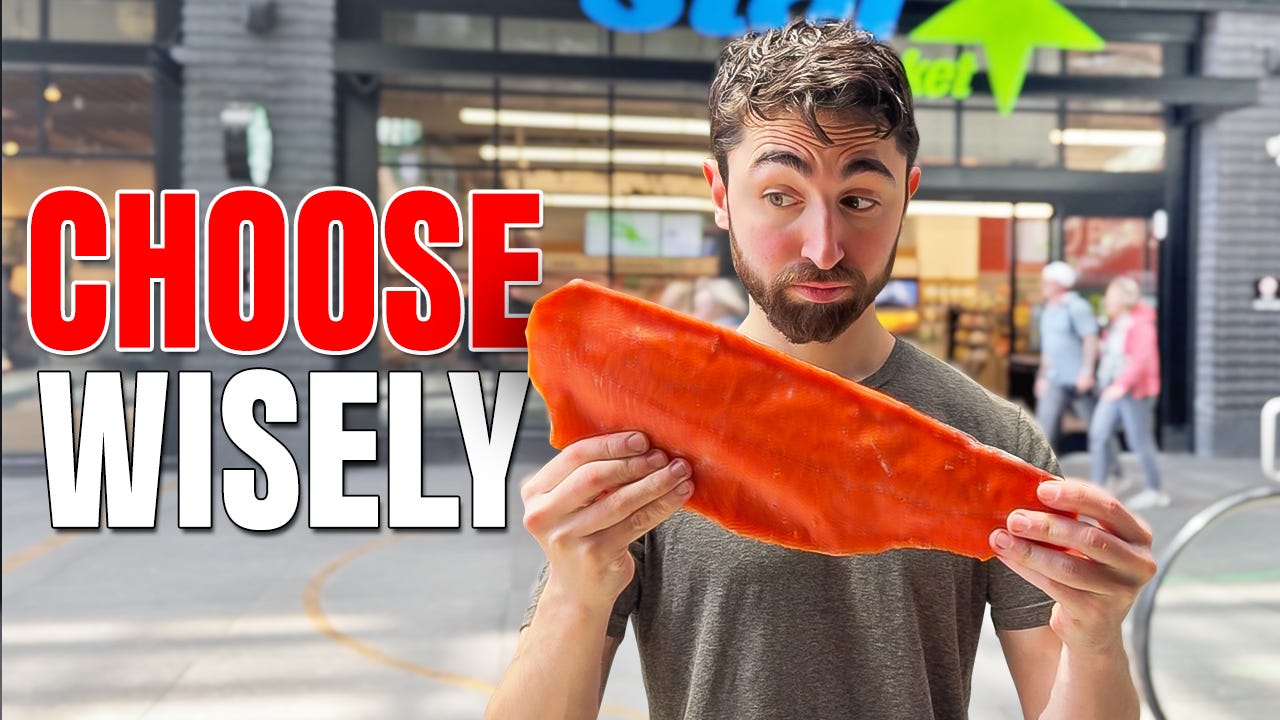Salmon Savvy: The Ultimate Guide to Choosing the Cleanest, Healthiest Fish
Salmon might wear the health halo, but not all salmon are created equal. Let’s talk fish fraud and how to avoid getting catfished at the seafood counter
Salmon might wear the health halo, but under the surface, some fillets are packing more pollutants than a ‘90s diesel truck. Let’s talk fish fraud and how to avoid getting catfished at the seafood counter.
In this letter, you’ll learn why not all salmon are created equal—how some are loaded with more brain-boosting omega-3s and powerful antioxidants, while others are swimming in synthetic contaminants, carcinogens, and industrial byproducts.
We’ll break down the difference between wild and farmed, decode confusing labels, explore the power of astaxanthin, and rank six common types of salmon so you know exactly what to choose next time you’re at the store.
Farmed vs Wild Salmon
Let’s start with the elephant in the room—or manatee in the pool, as it were: farm-raised vs. wild salmon.
Is wild really better? … YES!
Contamination & Pollutants
The primary reason I always go wild over farm-raised is that farm-raised salmon tend to have much higher levels of chemicals like polychlorinated biphenyls (PCBs), pesticides, and dioxins, which largely derive from their feed and all of which have serious negative consequences on human health.
To take one of these as a representative example: dioxins, which are byproducts of various industrial processes such as burning waste, smelting metals, and bleaching. Some dioxins, like TCDD, are classified as Group I carcinogens (known to cause cancer in humans).
Anyway, one study found that when eating farm-raised salmon, it would be easy to exceed the tolerable daily intake (TDI) of dioxins based on thresholds set by the World Health Organization.
In some cases, as little as 4 servings of farm-raised salmon per month would push you past the dioxin TDI.
By comparison, this analysis found that you could eat wild salmon every single day and remain within safe levels of dioxin exposure.
*This graph shows the number of meals per month you’d need to eat of farm-raised salmon (white and light blue) or wild salmon (dark blue) to breach the safe intake limit. For farm-raised salmon, you can see only a handful of small servings will push you beyond the safe limit. But for wild salmon, they actually capped the analysis at “a practical consumption rate” of 60 meals/month.
Bottom line: The contamination is much greater in farm-raised salmon. By comparison, wild salmon is safer and healthier.
Fat Profile
Additionally, wild salmon tend to have a better fat profile—being richer in omega-3 but leaner overall—on account of the fact that they are active in the wild and eat a natural diet rich in omega-3, algae, krill, and smaller fish.
Farmed salmon, by comparison, are couch potatoes and fed artificial feed, usually fish pellets made of substances like chicken, chicken fat, soy, and so on.
Atlantic: Faroe Island, Norwegian, & Scottish
Most of the salmon you’ll see are Atlantic salmon, which are mostly farm-raised.
Three common types are: Faroe Island, Norwegian, and Scottish, named for their geographic origins.
Faroe Island: Are often sold at restaurants at a premium price because they tend to be extra fatty and tasty. However, one credit I’ll give Faroe Island salmon is that they are generally raised without antibiotics.
Norwegian: Quite common. About one-fifth of the salmon in the United States comes from Norway, and they are antibiotic-free 99% of the time.
Scottish: I don’t have much to say on these, although I’ve noted some scandals in the media. So, I suppose I’d just say so Scottish salmon are like a kilt… look traditional, but underneath it might be hiding something questionable.
Pacific: Coho, King (Chinook), & Sockeye
On the first two (Coho and King) there are farm-raised and wild options, and the labeling is usually clear—or you can ask your fishmonger.
Coho: Moderate fat content and a mild, nutty flavor, and is sometimes called the “newbie’s salmon” or “gateway salmon.”
King (Chinook): The largest salmon and the fattiest wild salmon. Their flavor is excellent, and they usually capture the highest price. So, I call them “date night salmon.” They don’t match Alaskan Sockeye for nutritional bang-for-the-buck, but they taste great and are a good option if you’re cooking to impress.
And, as a fun fact about King salmon, 6% have a genetic mutation that doesn’t allow them to process the red pigment astaxanthin (more below), resulting in ivory-colored “ghost salmon.” — haunting your dinner plate with high prices and low pigment.
And I’ve saved the best for last…
Alaskan Sockeye are always wild. They’re relatively lean but high in omega-3. And they are the reddest and richest in that red pigment, astaxanthin.
Astaxanthin
Astaxanthin is why salmon are pink-red, and it also happens to be a potent antioxidant with some exceptional properties.
Astaxanthin is a powerful antioxidant, with a free radical scavenging capacity ranging from 100 to 6,000-fold stronger than Vitamins C, E, or CoQ10.
Astaxanthin is also a multitasker. Using “electron dislocation resonance” — basically a chemical force field — astaxanthin can simultaneously neutralize up to 20 different free radicals at the same time. Most other antioxidants can’t do this. Eat your heart out vitamin C.
In the rest of this letter I will:
Rank the Astaxanthin Content of Salmon
Tell you How to Lower Mercury Absorption
Review Salmon’s Micronutrient Profile
Share Fun Facts about my Favorite Fish
Provide a Types of Salmon Comparison Table
*And, as a reminder, the cost of a monthly or annual premium subscription averages to <$1 per letter. Thanks!
Keep reading with a 7-day free trial
Subscribe to Nicholas’s Substack to keep reading this post and get 7 days of free access to the full post archives.






